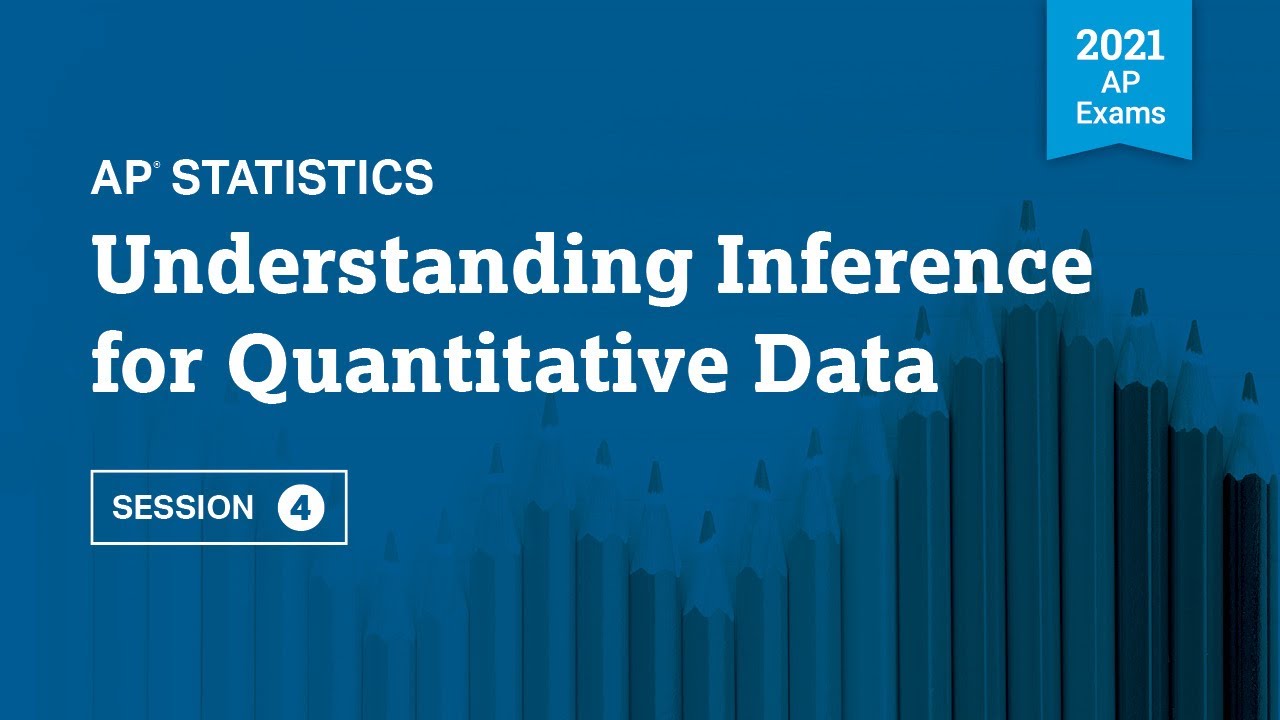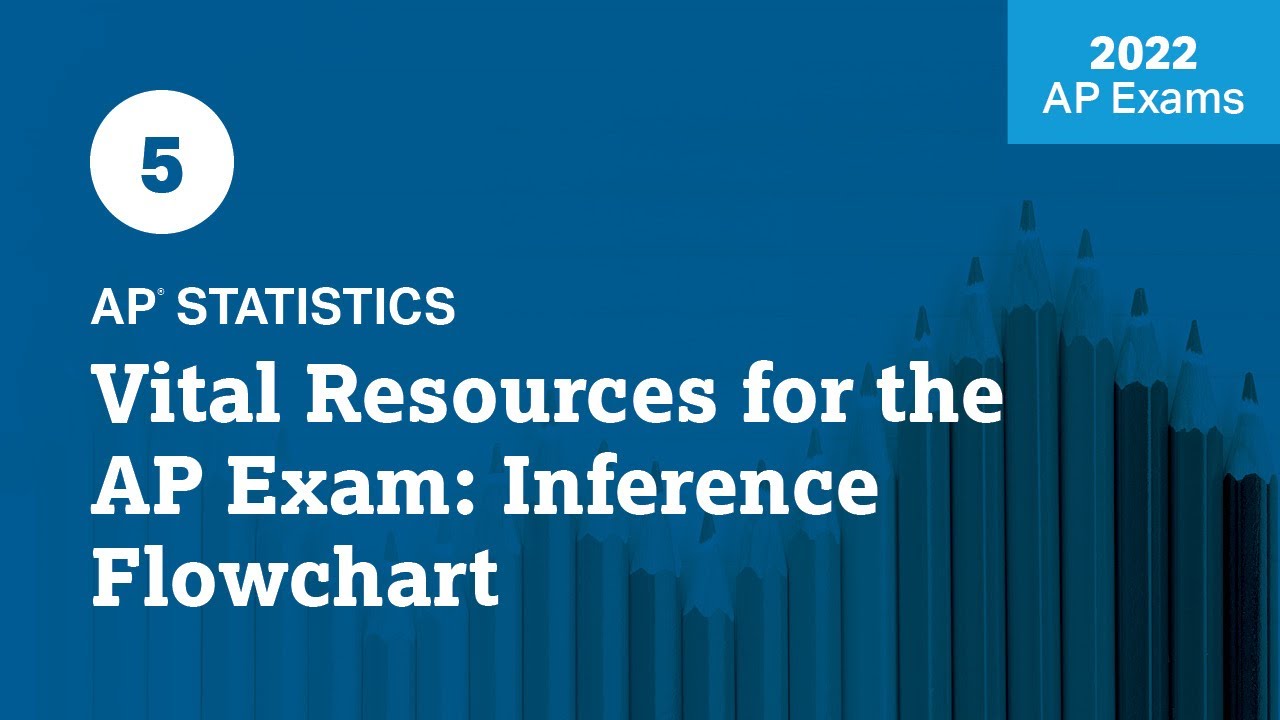5 | MCQ | Practice Sessions | AP Statistics
TLDRIn this AP Daily practice session, Mr. Starnes guides students through multiple-choice questions on statistical inference from units 6 to 9. He covers confidence intervals, sample size calculations for margin of error, hypothesis testing for proportions, chi-square tests for association, and regression analysis. Each question is dissected to highlight key concepts and strategies for tackling similar problems, aiming to prepare students for the AP exam.
Takeaways
- 📚 The session is focused on multiple choice questions from units 6 through 9 on statistical inference for AP Stat students.
- 🔍 Mr. Starnes emphasizes the importance of focusing on key words and phrases during the exam to aid interpretation and problem-solving.
- 📈 The first question deals with interpreting a 95% confidence interval correctly, highlighting that it refers to the population mean, not individual observations.
- 🧐 The strategy of anticipating the answer before looking at the choices is suggested as a way to approach multiple-choice questions on the exam.
- ❌ Incorrect answer choices are explained, helping students understand why certain interpretations of confidence intervals are wrong.
- ✅ The correct interpretation of a 95% confidence interval is that 95% of all such intervals would contain the true population mean if the sampling process were repeated many times.
- 📝 Question two involves calculating the smallest sample size needed for a given margin of error in a confidence interval for a proportion, requiring knowledge of the formula for the standard error.
- 📉 The concept of power in hypothesis testing is introduced, explaining that it is the probability of correctly rejecting the null hypothesis when the alternative is true.
- 📊 Question three discusses factors that affect the power of a test, such as sample size and significance level, with a larger sample size and a higher significance level generally leading to greater power.
- 🤔 The chi-square test and its interpretation are covered in question four, including how to determine the p-value from a test statistic and degrees of freedom.
- 📊 Question five introduces regression analysis, explaining the process of testing the null hypothesis about the slope of the population regression line.
- 📝 The final question addresses the appropriate statistical test for a study comparing two conditions within the same group of participants, highlighting the use of a matched pairs t-test for analyzing mean differences.
Q & A
What is the main focus of the AP Daily practice session presented by Mr. Starnes?
-The main focus of the session is on multiple choice questions from units 6 through 9 on statistical inference for AP Stat students.
What is the purpose of the confidence interval in the first question of the session?
-The purpose of the confidence interval is to estimate the mean size in acres of farms in the United States with a 95% confidence level.
How does Mr. Starnes suggest students approach interpreting a confidence level on the exam?
-Mr. Starnes suggests students anticipate the answer by thinking about repeating the sampling process many times and considering what percent of the intervals would capture the true population parameter.
What is the correct interpretation of a 95% confidence level for the first question in the session?
-The correct interpretation is that approximately 95% of all random samples of size 30 from the population will produce intervals that contain the mean size of farms in the US.
What is the formula for calculating the margin of error for a confidence interval of a proportion, as discussed in the second question?
-The margin of error is calculated using the formula: Margin of Error = Critical Value * (sqrt(p_hat * (1 - p_hat)) / sqrt(n)), where p_hat is the sample proportion and n is the sample size.
Why is the sample size of 188 not sufficient for the second question's scenario?
-The sample size of 188 is not sufficient because when rounding up to the nearest whole number, at least 200 samples are needed to ensure the margin of error is no more than six percentage points.
What is the concept of 'power' in the context of hypothesis testing discussed in the third question?
-The power of a test is the probability that the test will correctly reject the null hypothesis when the alternative hypothesis is true.
What factors contribute to the highest power for a hypothesis test according to the third question?
-The highest power for a hypothesis test is achieved with a larger sample size and a lower significance level, as these factors make it easier to reject the null hypothesis when it is false.
How is the p-value determined in a chi-square test, as mentioned in the fourth question?
-The p-value is determined by looking up the chi-square statistic in a table or using technology to calculate the probability of observing a statistic as extreme or more extreme than the one calculated, given the null hypothesis is true.
What is the appropriate test statistic for testing the null hypothesis that the slope of the population regression line equals 0, as discussed in the fifth question?
-The appropriate test statistic is the standardized test statistic, which is the coefficient of the exercise time (the slope of the sample regression line) minus the null value (0), divided by its standard error.
What type of t-test is most appropriate for analyzing the data in the sixth question regarding the effect of multitasking on cognitive tasks?
-A matched pairs t-test is most appropriate for analyzing the data because each participant performed both the single task and the multitask, allowing for the comparison of the mean difference in task completion times.
Outlines
📊 AP Statistics Practice: Confidence Intervals & Sample Size Calculation
In this session, Mr. Starnes introduces an AP Daily practice focusing on statistical inference from units 6 to 9. He emphasizes the importance of understanding confidence intervals and begins with a question about interpreting a 95% confidence interval for the mean size of U.S. farms. The correct interpretation is that approximately 95% of all possible samples of size 30 would produce intervals that contain the true mean size of farms in the U.S. Mr. Starnes then moves on to a question about calculating the smallest sample size needed for a 90% confidence interval with a margin of error less than six percentage points, illustrating the process of using the standard error formula and solving for 'n' to ensure the margin of error requirement is met.
🗳️ Power of a Test & Chi-Square Test for Association
The session continues with a discussion on the power of a test for proportions, using a scenario where a mayor wants to determine if more than 30% of voters support him to decide whether to run for governor. Mr. Starnes explains that a larger sample size and a lower significance level will increase the power of the test. Following this, he addresses a chi-square test for association between running experience and sports injury occurrence among marathon runners. He calculates the p-value for the test using both a table lookup and technology, concluding that there is a significant association between the two variables.
📉 Regression Analysis & Testing the Significance of the Regression Line
In the third paragraph, Mr. Starnes delves into regression analysis, discussing a study that shows a negative linear relationship between exercise time and running time. He explains how to find the appropriate test statistic for testing the null hypothesis that the slope of the population regression line equals zero. The correct approach involves using the coefficient of exercise time as the test statistic and dividing it by its standard error. Mr. Starnes clarifies that this is not an inference about a mean but specifically about the slope, avoiding common pitfalls in the answer choices.
⌨️ Matched Pairs t-Test for Multitasking Effects on Cognitive Tasks
The final paragraph discusses a study on the effects of multitasking on cognitive task completion, specifically text typing times on a smartphone. The study involved 40 women typing a passage in both a single-task and a multitasking scenario. Mr. Starnes explains that since the same participants performed both tasks, a matched pairs t-test is the most appropriate analysis method. This test will compare the typing times between the two conditions to determine if multitasking significantly affects performance. He wraps up the session by encouraging students to practice more using resources in the AP Classroom and announces the next session's topic.
Mindmap
Keywords
💡Confidence Interval
💡Statistical Inference
💡Random Sample
💡Margin of Error
💡Proportion
💡Power of a Test
💡Significance Level
💡Chi-Square Test
💡Degrees of Freedom
💡P-Value
💡Regression Analysis
💡Standardized Test Statistic
💡Matched Pairs t-Test
Highlights
Introduction to AP Daily practice sessions focusing on statistical inference for AP Stat students.
Emphasis on downloading and attempting multiple choice questions from units 6 through 9 before the session.
Explanation of the correct interpretation of a 95% confidence interval in the context of agricultural farm sizes.
Strategy for anticipating the correct answer before looking at the choices on the exam.
Clarification that the confidence interval is about the population mean, not individual farm sizes.
Process of eliminating incorrect answer choices based on the focus of the confidence interval.
Final answer identification for the first question, highlighting the correct interpretation of the 95% confidence level.
Introduction of a calculation-based question regarding the sample size for a 90% confidence interval with a specific margin of error.
Explanation of the formula for the confidence interval for a proportion and its components.
Calculation of the smallest sample size needed to achieve a margin of error of no more than six percentage points.
Discussion on the power of a large sample test for proportions and its relation to sample size and significance level.
Identification of the situation that yields the highest power for the test when the true population proportion is known.
Analysis of a chi-square test statistic and its relation to the p-value in a study investigating the association between running experience and sports injury.
Method for determining the p-value using either a table or technology for a given chi-square test statistic.
Regression analysis on the relationship between exercise time and running time, with a focus on testing the null hypothesis about the slope of the population regression line.
Identification of the appropriate test statistic for the slope of the regression line from the computer output.
Study on the effect of multitasking on cognitive task completion, with a focus on the most appropriate statistical test for the collected data.
Decision-making process for choosing between a two-sample t-test and a matched pairs t-test for analyzing the impact of multitasking on typing time.
Encouragement for further practice using AP Classroom resources and an announcement for the next session on insurance-related free-response questions.
Transcripts
Browse More Related Video

2021 Live Review 4 | AP Statistics | Understanding Inference for Quantitative Data

AP Statistics Unit 6 Summary Review Inference For Proportions Part 1 Confidence Intervals

2022 Live Review 2 | AP Statistics | Making Sense of Probability & Random Variables

7 | FRQ (Part B, Question 6: Investigative Task) | Practice Sessions | AP Statistics

2022 Live Review 5 | AP Statistics | Vital Resources for the AP Exam: Inference Flowchart

1 | MCQ | Practice Sessions | AP Statistics
5.0 / 5 (0 votes)
Thanks for rating: